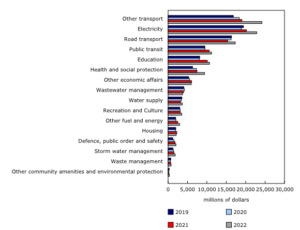
Capital spending expected to grow
By Adam Freill
Construction InfrastructureInfrastructure projects, including roads and pipelines, among the many industry classifications showing growth in the 2022 and 2024 reports.

Capital expenditures, infrastructure assets, by function. (Source: Statistics Canada, Table 34-10-0280-01)
Total capital expenditures by businesses and governments on non-residential tangible capital assets are expected to increase by 4.5 per cent this year, reaching $353.9 billion, according to the latest figures released by Statistics Canada. This, says the government agency, represents a fourth consecutive annual increase.
Capital spending in mining, quarrying, and oil and gas extraction is expected to top $60 billion in 2024, while the manufacturing sector is also expected to see considerable growth in capital spending, with Statistics Canada expecting an increase of 31 per cent, to $36.2 billion.
Leading this spend are several major project announcements supported by multiple federal and provincial government programs aimed at incentivizing developments in decarbonization and clean energy. The Canada Energy Regulator announced the construction of seven new renewable diesel facilities in Canada following the implementation of the federal government’s 2020 Clean Fuel Regulations. In January 2024, Ontario announced that it had attracted $27 billion in new investments in the past three years related to motor vehicle and electric vehicle manufacturers and suppliers. Quebec and British Columbia have also announced major investments in the battery supply chain.
In addition, a major chemical manufacturer recently announced an investment of more than $11.5 billion in a net-zero emissions ethylene facility, while an industrial gas manufacturer announced a new $1.6 billion net-zero emissions hydrogen energy complex.
If intentions are realized, public sector organizations will end up investing $131.8 billion in 2024, following seven years of consecutive growth.
The utilities sector is the second-largest contributor to the anticipated growth in public investments, with a $3.2 billion increase, almost 12 per cent growth, to bring it to $30.6 billion. Additionally, private businesses in utilities anticipate a four per cent increase in capital spending, to reach $11.8 billion in 2024.
Ontario and Quebec are expected to account for 82.9 per cent of the increased capital expenditures in 2024 for this sector. Major refurbishments and small modular reactor projects continue at nuclear generating stations in Ontario. Meanwhile, Hydro-Québec announced plans to almost double its investments in network sustainability by 2035 to reduce power outages by 35 per cent and to invest at least $90 billion in the addition of 8,000 to 9,000 megawatts of capacity and 5,000 kilometres of transmission lines.
Capital expenditures on Canadian infrastructure increase by 13.4% in 2022
The Statistics Canada report included a look at 2022 infrastructure investments, which grew by 13.4 per cent that year. Total capital spending on infrastructure assets, including on social and affordable rental housing, grew by $14.5 billion, to reach $122.6 billion that year.
Growth was observed for 13 of the 16 infrastructure functions. The two largest contributors of growth were the “other transport” category, which includes air, rail, water and pipeline, and was up $5.1 billion, and electricity, which rose $2.7 billion. Major construction projects in pipeline transportation and in the electric power grid continued during the year.
Capital expenditures on infrastructure assets were largest in either the road transport function or the electricity function in seven provinces and one territory. Major pipeline projects in B.C. and Alberta saw the “other transport” function exceeded all others in those two provinces.




